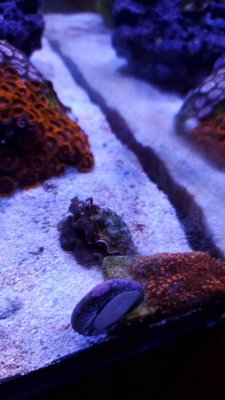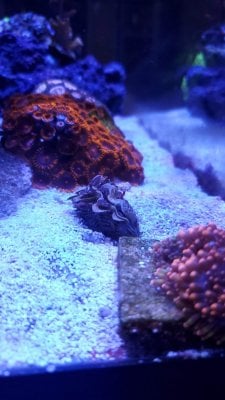Navigation
Install the app
How to install the app on iOS
Follow along with the video below to see how to install our site as a web app on your home screen.
Note: This feature may not be available in some browsers.
More options
You are using an out of date browser. It may not display this or other websites correctly.
You should upgrade or use an alternative browser.
You should upgrade or use an alternative browser.
First off get it off the sand and onto a hard surface, being on sand can be irritating to T. maxima and T. crocea 's byssal gland as they are boaring clams.
What's the PAR down there? are you feeding phyto/food suspensions? they rely a lot on filter feeding at that size.
What's the PAR down there? are you feeding phyto/food suspensions? they rely a lot on filter feeding at that size.
- Joined
- Jan 8, 2014
- Messages
- 15,906
- Reaction score
- 50,359
Maximas can do just fine in a sand bed as long as they have enough par and feeding a clam is not necessary given they have the proper tank conditions and lighting. It looks as if the clam is unhappy in the current spot but there is also new growth so that's a good sign. Try relocating to another area with less flow and you can place it on a harder surface if you like which will make it easier to move the clam up to higher light if need be.
Thanks, I wasn't aware that they didn't like sand beds. I was informed of the opposite. I'll get him onto some rocks. It's lower par, closer to 125-150. I feed frozen Rod's and on occasion add some coral food into the mix and broadcast feed. Should I target feed it?First off get it off the sand and onto a hard surface, being on sand can be irritating to T. maxima and T. crocea 's byssal gland as they are boaring clams.
What's the PAR down there? are you feeding phyto/food suspensions? they rely a lot on filter feeding at that size.
Okay thank you, i'll move him up and see how he does.Maximas can do just fine in a sand bed as long as they have enough par and feeding a clam is not necessary given they have the proper tank conditions and lighting. It looks as if the clam is unhappy in the current spot but there is also new growth so that's a good sign. Try relocating to another area with less flow and you can place it on a harder surface if you like which will make it easier to move the clam up to higher light if need be.
- Joined
- Jan 8, 2014
- Messages
- 15,906
- Reaction score
- 50,359
How long has he been in the tank?Okay thank you, i'll move him up and see how he does.
About 6 months, and he was doing well too.How long has he been in the tank?
- Joined
- Jan 8, 2014
- Messages
- 15,906
- Reaction score
- 50,359
I would try to relocate him in a spot of decent light, low flow and an area where the clam has less of a chance to fall. Once it lays its byssal threads you will be able to move the clam around easier. Once the clam starts doing better then try not to intervene if not necessary.
Thanks, I wasn't aware that they didn't like sand beds. I was informed of the opposite. I'll get him onto some rocks. It's lower par, closer to 125-150. I feed frozen Rod's and on occasion add some coral food into the mix and broadcast feed. Should I target feed it?
Only T. maxima, T crocea and T. noae should absolutely be kept on rock or at least large rubble, never fine or reef grade sand, others like T. deresa and T. squamosa are fine with sand.
T. maxima, crocea and noae secrete acids from their byssal gland to "bore" into rocks and corals in the wild, you will rarely, if ever, see these species on the substrate in the wild. Maybe some have kept and had decent luck with them on substrate but it's not proper husbandry for mentioned species IMO.
If you have had it 6mo have you noticed new growth on its shell? are you feeding it? lighting?
- Joined
- Jan 8, 2014
- Messages
- 15,906
- Reaction score
- 50,359
I respectfully disagree and I'm sorry, making a statement that clams kept on a sand is poor husbandry is just not factual. I grew sand dwellers on barebottom tanks, is that wrong? I suggest reading up on articles on tridacna as crocea is the real "rock boring" species. Just because clams are rock dwellers does not make them boring species and can not be kept on the sand bed. I've grown many species over many years and it's been well documented that while feeding tridacna does not hurt the clam, it's not necessary for survival if all other needs are met.
I respectfully disagree and I'm sorry, making a statement that clams kept on a sand is poor husbandry is just not factual. I grew sand dwellers on barebottom tanks, is that wrong? I suggest reading up on articles on tridacna as crocea is the real "rock boring" species. Just because clams are rock dwellers does not make them boring species and can not be kept on the sand bed. I've grown many species over many years and it's been well documented that while feeding tridacna does not hurt the clam, it's not necessary for survival if all other needs are met.
"I’ll also add that while T. maxima reportedly lives on sand on occasion, I have yet to see one that wasn’t attached to a hard substrate after many dives in many places. So I’m under the impression that it isn’t common for maximas to live on sand, unless maybe that’s all that’s available in a particular area"
(Fatherree)
I have also read in Daniel Knops book on tridacnid that maximas should be kept on rock.
too each there own though, just sharing my opinion and understanding of them.
- Joined
- Jan 8, 2014
- Messages
- 15,906
- Reaction score
- 50,359
That's what we are here for, to share and help others. I just dont think it's fair to tell someone they have poor husbandry because they grow a maxima on the sand bed. Trust me, plenty of members here have done that successfully. Typically once large enough they ditch the byssal threads. Tridacna are fascinating for sure."I’ll also add that while T. maxima reportedly lives on sand on occasion, I have yet to see one that wasn’t attached to a hard substrate after many dives in many places. So I’m under the impression that it isn’t common for maximas to live on sand, unless maybe that’s all that’s available in a particular area"
(Fatherree)
I have also read in Daniel Knops book on tridacnid that maximas should be kept on rock.
too each there own though, just sharing my opinion and understanding of them.
Agreed that it can be done, and many surely have had success with T. maxima on substrate, but just like croceas they ALSO do bore into rock via byssal produced acids, Its in Knops book.That's what we are here for, to share and help others. I just dont think it's fair to tell someone they have poor husbandry because they grow a maxima on the sand bed. Trust me, plenty of members here have done that successfully. Typically once large enough they ditch the byssal threads. Tridacna are fascinating for sure.
Look at every pic of a T. maxima in the wild, they are embedded in rock up to their mantle almost always, to me correct husbandry is recreating their natural habitat, for any animal.
That's just my .02 though.
OP, DSC reef is NOT wrong, you can successfully keep the maxima on the sand bed if you choose, however you will more than likely struggle to fulfill its lighting needs unless you have a really powerful lighting setup or a shallow tank.
Thank you both for the insight. Much appreciatedAgreed that it can be done, and many surely have had success with T. maxima on substrate, but just like croceas they ALSO do bore into rock via byssal produced acids, Its in Knops book.
Look at every pic of a T. maxima in the wild, they are embedded in rock up to their mantle almost always, to me correct husbandry is recreating their natural habitat, for any animal.
That's just my .02 though.
OP, DSC reef is NOT wrong, you can successfully keep the maxima on the sand bed if you choose, however you will more than likely struggle to fulfill its lighting needs unless you have a really powerful lighting setup or a shallow tank.
Your clam looks like it needs more light. The 2 other posters have said the important stuff so just move him higher and watch him.
FWIW. Parameters are key and water can have a little nitrates. With clams under 2" I start my clams on the sand bed with larger broken up rock from my tank...like dime size to acclimate to my lights and water. I only add phyto/oyster 2/3 times a week with poweads off but I make sure it waterfalls to the area. I do not splash spot feed and this is only for the little guys under 2". I then built a rock clam "bed if you will" where they end up where the par is much higher were they like it then enjoy!
Maxima clams will move and even climb rocks to get where they want. So dont be scared if they move everyday until they are happy. And I know not every clam will "walk" and some just die unfortunately when they get unhappy.
Once again just my experience and opinion.
FWIW. Parameters are key and water can have a little nitrates. With clams under 2" I start my clams on the sand bed with larger broken up rock from my tank...like dime size to acclimate to my lights and water. I only add phyto/oyster 2/3 times a week with poweads off but I make sure it waterfalls to the area. I do not splash spot feed and this is only for the little guys under 2". I then built a rock clam "bed if you will" where they end up where the par is much higher were they like it then enjoy!
Maxima clams will move and even climb rocks to get where they want. So dont be scared if they move everyday until they are happy. And I know not every clam will "walk" and some just die unfortunately when they get unhappy.
Once again just my experience and opinion.
All the clams will do fine in our sand bed if they have enough light. I almost always keep my clams, all 6 species of Tridacna, on sand bed. That is not to say that Crocea, Maxima and Noae live on sand bed in the wild. However, our tank is not "in the wild" and they will do great on sand bed. I often have very deep sand so they often don't attach to anything.
I keep them low on the sand bed so they can be view much better.
I keep them low on the sand bed so they can be view much better.




















